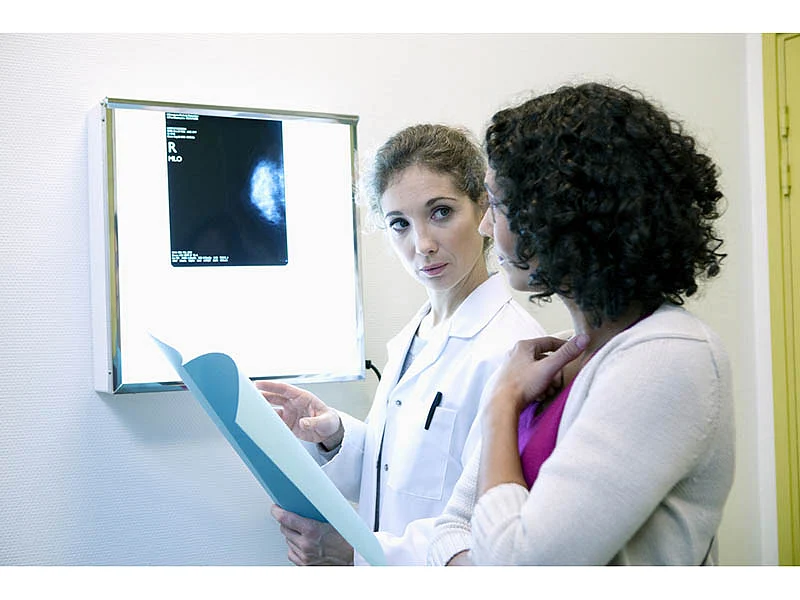
Mammograms Can Also Highlight Heart Risks
Last Updated on March 17, 2022 by Admin
[ad_1]

WEDNESDAY, March 16, 2022
Your annual screening mammogram may do more than spot breast cancer early — it may give you a heads up on your heart disease risk, too.
Digital breast X-rays can also detect a build-up of calcium in the arteries of your breasts, an early sign of heart disease. These white areas — known as breast arterial calcification, or BAC — are markers of hardening in the arteries and tend to go along with advancing age, type 2 diabetes, high blood pressure and inflammation. (It is not the same as calcification of the inner layer of the arteries that is often found in smokers or people with high cholesterol.)
“A single test that is universally accepted can address the two leading causes of death in women,” said study author Dr. Carlos Iribarren. He is a research scientist at the Kaiser Permanente Northern California Division of Research, in Oakland.
For the study, his team reviewed health records of more than 5,000 women, aged 60 to 79, who underwent one or more screening mammograms. None of these women had a history of heart disease or breast cancer when the study began. They were followed for about 6.5 years.
Those whose mammogram showed breast arterial calcifications were 51% more likely to develop heart disease or have a stroke compared with women without calcium build-up in their arteries, the study found.
In addition, women with calcium build-up were 23% more likely to develop any type of heart or vascular disorder, including heart disease, stroke, heart failure and related diseases, the study showed.
“BAC provides additional information and is not intended to replace any current risk factors for heart disease,” Iribarren said.
Counseling should be done in the context of a woman’s overall heart disease risk, he said.
“For women with low risk, BAC presence should be a trigger of adhering to healthy lifestyles including a heart-healthy diet, avoiding smoking and exercising regularly,” he advised. “For women with intermediate-risk, BAC should also prompt a discussion with the doctor about initiating treatment for risk factors such as cholesterol, blood pressure and diabetes that are not well controlled by lifestyle alone.”
Although reporting of BAC levels is not mandatory, radiologists should include this information in their report, Iribarren said.
“A relatively small proportion already do, but more importantly, there is research showing that women overwhelmingly want this information provided to them and their primary care doctors,” he said.
Because this information can be obtained during a routine screening mammogram, there would be no extra cost or radiation exposure.
SLIDESHOW
Heart Disease: Causes of a Heart Attack
See Slideshow
The findings were published March 15 in the journal Circulation: Cardiovascular Imaging.
Dr. Natalie Avella Cameron, an instructor at Northwestern University’s Feinberg School of Medicine in Chicago, co-wrote an editorial that accompanied the findings.
“If future research shows that BAC improves heart disease risk prediction among women not yet on cholesterol-lowering medications, BAC could serve as a powerful tool to help guide heart disease prevention for the millions of women who undergo routine mammography each year,” she said.
But, Cameron noted, women without calcium build-up on their breast arteries can still develop heart disease.
“We should be assessing heart disease risk factors such as obesity, high blood pressure, high cholesterol and diabetes, and discussing how to optimize heart health through lifestyle changes such as eating a plant-based diet and staying active, regardless of BAC status,” she said.
Knowledge of BAC status could be powerful and potentially life-saving information, said cardiologist Dr. Nieca Goldberg, who reviewed the findings. She’s medical director at Atria New York City and a clinical associate professor of medicine at New York University.
“Heart disease is the No. 1 killer of women, yet many women are more worried about breast cancer,” Goldberg said. “Women’s health issues are not siloed. A test for breast cancer can give us clues to heart disease risk, too.”
Calcium build-up in arteries is an early sign of heart disease risk, she said.
“We don’t know how any intervention would change calcifications, but exercising, quitting smoking, getting diabetes under control, eating a healthier diet, and managing cholesterol and blood pressure can help lower risk for heart attack,” Goldberg said.
More information
Women can learn more about their risk for heart attack and strokes at Go Red for Women.
SOURCES: Carlos Iribarren, MD, MPH, PhD, research scientist, Kaiser Permanente Northern California Division of Research, Oakland; Natalie Avella Cameron, MD, instructor, medicine, Northwestern University Feinberg School of Medicine, Chicago; Nieca Goldberg, MD, medical director, Atria New York City, and clinical associate professor, medicine, New York University, New York City; Circulation: Cardiovascular Imaging, March 15, 2022

Copyright © 2021 HealthDay. All rights reserved.
From 
Health Solutions From Our Sponsors
[ad_2]
Source link





